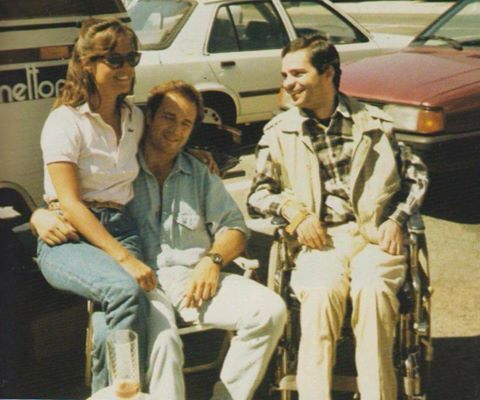A few days after the Monaco Grand Prix (which proved to another disappointing race for Elio, retiring just before a quarter distance whilst last) the Brabham team travelled to Paul Ricard to take part in an annual post-Monaco testing session along with a number of other F1 teams. Riccardo Patrese was initially pencilled in to journey to Ricard to carry out the test session, however Elio specifically asked if he could do the test primarily out of his disappointing showing in the Monaco Grand Prix but tragically it was to end in a fatal accident.
During this test session on the morning of May 14th 1986 at around 11:00AM the unthinkable happened – Elio’s Brabham BMW BT55/3 car suffered an accident due to a rear wing failure going into the high speed 180mph verrerie curves which in turn pitched the car into a series of somersaults before vaulting the guardrail on the right-hand side of the track, eventually coming to rest upside down some 100 yards away from the initial accident. To this day, the only known witnesses to the crash were two Benetton mechanics who were operating speed guns.
The marshalling shambles that followed was absolutely scandalous, as Elio remained trapped upside down in the cockpit for as long as 10 minutes whilst the car started to slowly catch fire.
The first person in attendance was Alan Jones, who later commented that “There was nothing I could do, I just stood there with my hands in the air. Bloody dreadful”. Jones was soon joined by fellow F1 drivers Alain Prost and Nigel Mansell as they attempted to right the car, but found that they could not get near it due to the heat and crackling. Eventually they were joined by a marshal wearing nothing but shorts and a tee shirt as he attempted to put the fire out.
However, as Alan Jones noted “most of the powder went into the cockpit rather than on the engine fire. Apart from anything else, the powder would have done Elio no good…”.
After approximately 10 mins trapped inside the car, Elio was finally extracted. However, as the circuit had no helicopter another 30 mins elapsed before one could be flown in from nearby Marseille and Elio finally could get taken to nearby Marseille hospital.
Despite the massive impact, the Brabham BT55 had stood up well to the accident, a tribute to the build quality of chief designer Gordon Murray. This was proved when the full extent of Elio’s injuries became apparent – a broken collar bone and light burns to his back. What became clear however, was that the ensuing fire in the cockpit had almost certainly deprived Elio of oxygen and in any case this proved fatal.
That night following Elio’s accident, Syd Watkins was called by a surgeon at the Marseilles hospital and was informed that Elio had suffered massive brain damage and the situation was hopeless for him. It was perhaps a blessing when Elio died the following day, the official cause being “serious head and chest injuries”.
To lose any driver in this sort of fashion was totally inexcusable. What appalled most of the F1 community was the manner in which his life was just tossed away, and had Elio received prompt medical attention, he would have been giving at least a fighting chance of survival.
Soon after the testing accident at Paul Ricard, FIA President Jean Marie Balestre introduced a series of reforms, the most notable of which were the reduction of engine power for 1987, and the bi-sectioning of the Paul Ricard circuit to cut out the S bend where Elio suffered his accident. Many felt that these reforms were just a “knee jerk” reaction, particularly as there was no evidence to suggest that the ultra fast ‘Verrerie’ curve had in fact been the cause of the accident.
The real issue that needed addressing was the shocking state of marshalling present, and the lack of medical facilities at the circuit that fateful Tuesday. In all honesty, the French GP should have been cancelled pending a full investigation.
The serious shortcomings in safety witnessed at Elio’s testing accident at Paul Ricard were present for all to see when in July 1986, Paul Ricard hosted the French GP and millions who watched were treated to a marshalling display that resembled something out of the keystone cops. Anyone who saw Phillipe Streiff’s Tyrrell incinerate itself whilst the French fire brigade drove the wrong way up the pit lane, and then spew foam all over the track might perhaps have been forgiven for laughing. But deep down it really was no laughing matter.
F1 has come a long way in terms of safety. The sad death of Ayrton Senna in 1994 cannot be attributed to poor marshalling or circuit facilities, and it was a relief to all watching to see such prompt medical attention given to the driver (as was the case in Gerhard Berger’s 1989 shunt at Imola).
It was desperately sad that the Formula 1 circus should lose such a prominent driver at an almost forgotten private testing accident at Paul Ricard, outside of the public eye. How ironic, then, that Elio loathed testing and perhaps never really understood the point of it all. He always felt that F1 drivers got enough practice during race weekends and was once rocketed by Colin Chapman for saying so.

